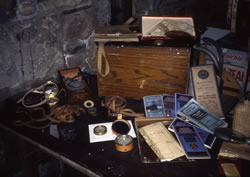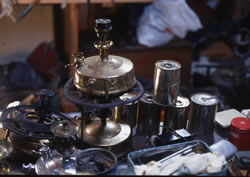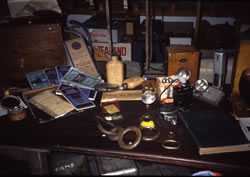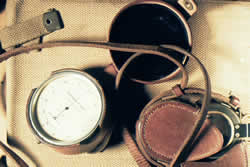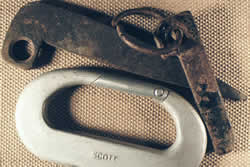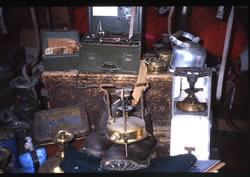
The Scottish Mountain Heritage Collection
About the Collection
A Brief History of The Scottish Mountain Heritage Collection
Napoleon it was who asserted that “England was a nation of shopkeepers” but I have been unable to find a quote which asserts that the British are a nation of collectors, even when the evidence points that way. It is difficult to find someone who doesn’t collect something or other, even though objects collected, such as barbed wire, bus tickets or supermarket carrier bags, may seem odd to some.
Not wishing to buck the national trend, somewhere back in the mists of time, I started collecting mountaineering equipment. Most mountaineers can find a place on the wall for an old ice axe, a pair of wooden skis maybe, or perhaps granddad’s old primus stove polished on the mantelpiece. The problem is when to stop.
As with everything else in life, mountaineering gear comes in all shapes and sizes, various makes and models, and perhaps more importantly, a story. The gentleman mountaineer of the late 1800’s with his rich portmanteau gave way to the working class folk of the 1920’s and 30’s who would use old military gear if they could afford it, or make their own if they couldn’t. A similar era ensued after World War 11 and each of these eras has left a legacy of literature and equipment which we can now collect... the antiques of the mountaineer.
My personal collection soon became a scrum of junk in the lovely stone built barn which was built expressly for – a different purpose! Pungent, primus stove aromas would assault the nostrils when the door was opened and a wrong move might trigger an avalanche of skis, old ice axes or rucksacks. Ancient first aid kits would be at the ready for puncture wounds from a rusty ice screw, crampon, or bent ski pole. Items were bought at auction, lofts were cleared, bags posted, and in one case, a rare prototype ice axe was rescued from a fire. One way or the other the pile got bigger.
Quite why people collect things is perhaps left for the psychologists to decide. There comes a time, however, when something has to happen and I well remember a dear old friend of mine being moved to tears on discovering that his ‘pile of junk’ had been consigned to the skip by his wife while he was away on holiday. In my case, thoughts of what to do next were always put on the back burner while my life as a mountain guide required me to be elsewhere... until 2004.
The Nevis Partnership is an amalgam of interested parties gathered together to manage Ben Nevis and its environs for the common good. Members include the John Muir Trust, the Highland Council, The local Community Council, Scottish Natural Heritage, local landowners and others. In 2004, the Partnership applied for several thousand pounds of Heritage Lottery money to repair the Ben Nevis paths. Unfortunately, this initial request was refused since the good folk at the Heritage Lottery didn’t see much heritage in a footpath. Jonathon Hart was the Partnership manager at the time and knowing of my collection he asked if it could be included in a further bid to beef up the ‘heritage’ element. The second bid was successful and in the spring of 2006 several thousand pounds were allocated to the Ben Nevis footpath project, with a smaller amount being given to the collection - the money being allocated specifically to archive, catalogue and preserve the collection and provide the bespoke web-site that you see here. This funding was dependant on the collection becoming an official charity and this was achieved in December 2006 when The Scottish Mountain Heritage Collection was registered with the office of the Scottish Charity Regulator ( OSCR ) as number SCO37653.
So we have mucked out the barn, cleaned, polished, preserved and archived our way through the collection with the result here on the web site. No general public access to the collection at the moment but we are working on it. As an old friend of mine used to say, “Show me a man without a dream and I’ll show you a man who’s stone dead.”
Mick Tighe, Autumn 2009
